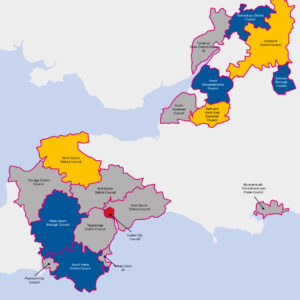
Company Director, and long-time East Fringe South Gloucestershire resident, James Hinchcliffe considers the political takeaways from South Gloucestershire’s publication of their Local Plan.
The new South Gloucestershire Council Cabinet has published its proposed blueprint for homes, employment, and infrastructure up to 2040. The Lib-Lab coalition partners will meet on 13 November 2023 to agree to move to public consultation on their preferred strategy. In summary, the Council is planning for 20,490 homes (using the National Standard Method) which comprises:
- 8,080: homes with planning permission already.
- 3,150: small site windfalls.
- 9,260: the current minimum number of new homes the Council needs to find land for.
Of these 9,260, there is an expected small site windfall uplift of 300 new homes, future urban allocations of 1,540 new homes (mostly comprised of locations in Lyde Green, Yate – Ladden, Yate Town Centre, and the former Grange site in Warmley), and 7,580 homes in new green field locations (with a concentration on the East Fringe and limited proposals for large-scale development elsewhere). Although there is much more below the surface of the document, these are the four immediate political takeaways we have spotted.
- The East Fringe – a new regional powerhouse?
- After sixteen years of the Tories leading South Gloucestershire Council, eight of those in overall control, the May 2023 local election result allows the new Lib-Lab coalition to look afresh at the East Fringe. Every South Gloucestershire Conservative campaign in the 21st century, whether at Parliamentary or Local Council level, has contained a steadfast commitment to protecting the area’s Green Belt.
- This tune was successful for Chris Skidmore MP in his first Parliamentary election in 2010, aiming fire at the Labour government’s Regional Spatial Strategies, and has chimed locally with some of the Conservative’s best results in May coming in East Fringe wards, like Parkwall and Warmley. Perhaps a change of the political guard would inevitably result in the East Fringe being looked at afresh.
- The preferred green field allocations in Shortwood, Warmley, Oldland Common, and Hanham, and commentary around the need for more employment to support these new communities represent a sea change for the Council. Had the Tories still been in charge, we would unlikely have been reading about the significant ambition for new homes and employment, particularly in Green Belt locations.
- Is this the end for Buckover Garden Village?
- The Tories had a love-hate relationship with Buckover. On the one hand, South Gloucestershire councillors favoured and identified the Garden Village as a 3,000 strategic location in 2018 as part of the abandoned JSP. Yet Luke Hall MP for Thornbury and Yate was firmly opposed and made this clear to the electorate at General Elections in 2015 and 2019. For the Liberal Democrats, the opposition to Buckover is just as ingrained, particularly from Thornbury.
- So, it probably suits the Lib-Lab administration that there is no appetite from National Highways to fund or design a solution for Junction 14, as revealed at the ongoing Stroud District Council Local Plan enquiry, and this represents the perfect opportunity to consider alternatives (see Takeaway 1).
- Where else is now ‘off the menu’ as preferred locations compared to the Tories? The clues are in the strategic areas identified in the 2018 JSP. Coalpit Heath is a clear example where some 1,800 homes were identified in 2018. And now, in 2023? 90 homes. The less intensive preferred allocation numbers for Yate and Thornbury may also have been different.
- What happens to Bristol’s overspill? Issue parked up for now
- Halloween gave a scare to Bristol City Council’s neighbours, including South Gloucestershire. “It’s not possible to deliver the entirety of assessed need inside Bristol’s boundaries…so neighbouring authorities are being asked if they would be in position to accommodate any of the local housing needs which would otherwise go unmet”, read the Bristol Local Plan report.
- The Lib-Lab response parks the issue: “At this stage, we have not considered the extent to which South Gloucestershire Council may or may not be able to take any part of this unmet need. We are firstly focusing on how we can sustainably meet our own needs.” So, this might not be the last time the Lib-Lab coalition visits the South Gloucestershire site map to consider where homes could fit – both to achieve a sound plan and avoid undue political controversy.
- A Lib-Lab coalition playing ball with Government targets
- The irony will not be lost that while the Government’s proposed watering down of targets to become ‘advisory’ and insistence that councils should not have to consider the Green Belt for development have resulted in some Conservative councils taking full advantage and suspending their Local Plans, the South Gloucestershire Lib-Lab coalition is running arms open to embracing targets and reviewing Green Belt to achieve their objectives.
- Is this surprising? The local policy positions of the Lib-Lab coalition appear to be broadly reflective of the national stance of both parties. A commitment to targets was agreed at the recent Liberal Democrat Party Conference and the Labour Party have shown openness to Green Belt release to support ‘the builders, not the blockers’.


